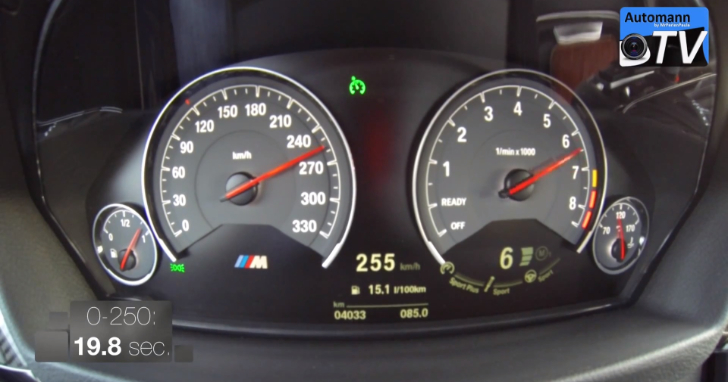Unfortunately for some thrill-seeking drivers out there, the new BMW M3 and M4 are being delivered, as stock, electronically limited at a top speed of 250 km/h (155 mph). Some would say that would suffice, but when your car reaches its top speed in just 20 seconds, it doesn’t seem all that fun, now does it?
That’s exactly what the new M3 is capable of. In the video below you’ll see how the car accelerates from 0 to 270 km/h (168 mph) and, honestly, it doesn’t even look like it’s breaking a sweat. Of course, as you probably guessed already, the car we’re looking at here is fitted with the M Driver’s Package that raises the speed limit to 280 km/h (174 mph).
What seems even more impressive are the times recorded to 100 km/h (62 mph) and 200 km/h (128 mph). This particular model was fitted with the 7-speed DCT gearbox that makes sure the shifts are as as quick as possible. According to BMW’s own estimates, that should propel the car to 100 km/h (62 mph) in 4.1 seconds. This car seems to be doing it in 3.9 seconds, 0.2 seconds faster.
Going further up, the speed doubles in just 8.7 seconds more, bringing the grand total it takes to go 200 km/h (128 mph) to 12.6 seconds. That’s almost as fast as the BMW M6 that has 560 HP and 680 Nm (501 lb-ft) of torque at its disposal to do so.
Taking this comparison just a bit further, the 3-liter S55 biturbo engine on the M3 with its 431 HP and 550 Nm (406 lb-ft) of torque turns the sedan into a missile that is just 0.5 seconds slower to 250 km/h (155 mph) than the much more powerful coupe.
All in all, the new M3 proved its worth over and over again. Sure, some things could’ve been better on it and that’s where we include the sound. The inline 6-cylinder still sounds great, even though it’s not a V8 and people should understand that difference.
However, with the old engine, such performance just wasn’t possible. The old S65 4-liter V8 mill sounded great and offered razor sharp throttle response but its 400 Nm (295 lb-ft) of torque were just too little for its own weight and today’s standards. As we said it before, this evolution had to happen.
What seems even more impressive are the times recorded to 100 km/h (62 mph) and 200 km/h (128 mph). This particular model was fitted with the 7-speed DCT gearbox that makes sure the shifts are as as quick as possible. According to BMW’s own estimates, that should propel the car to 100 km/h (62 mph) in 4.1 seconds. This car seems to be doing it in 3.9 seconds, 0.2 seconds faster.
Going further up, the speed doubles in just 8.7 seconds more, bringing the grand total it takes to go 200 km/h (128 mph) to 12.6 seconds. That’s almost as fast as the BMW M6 that has 560 HP and 680 Nm (501 lb-ft) of torque at its disposal to do so.
Taking this comparison just a bit further, the 3-liter S55 biturbo engine on the M3 with its 431 HP and 550 Nm (406 lb-ft) of torque turns the sedan into a missile that is just 0.5 seconds slower to 250 km/h (155 mph) than the much more powerful coupe.
All in all, the new M3 proved its worth over and over again. Sure, some things could’ve been better on it and that’s where we include the sound. The inline 6-cylinder still sounds great, even though it’s not a V8 and people should understand that difference.
However, with the old engine, such performance just wasn’t possible. The old S65 4-liter V8 mill sounded great and offered razor sharp throttle response but its 400 Nm (295 lb-ft) of torque were just too little for its own weight and today’s standards. As we said it before, this evolution had to happen.

